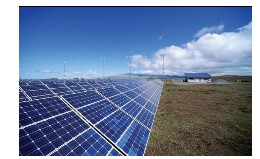
India has officially embarked on one of the most ambitious solar initiatives in the
world, and now that the first batch of solar projects have been approved under
Phase I of the Jawaharlal Nehru National Solar Mission (JNNSM), serious
project developers are now deciding "how" rather than "if" they will participate in
Indian's solar industry.
From a developer's perspective, India already has three very critical elements in
place for a world-leading solar program to be realized.
First and foremost, the natural resources (i.e. sunshine) necessary to support a
sustainable solar market are more than enough to power the entire country. After
the Sahara Desert, India is the sunniest location in the world - only 1 per cent of
India's land would be required to electrify the nation.
Second, the technology for solar is more accessible than ever; and efficient,
commercially proven solutions, are being tailored to the Indian market as we speak.
In fact, one of Astonfield's technology partners is now re-centering key parts of its
global solar engineering and design operation to India, given the innovation required
to deliver solutions at the aggressive cost points demanded by Indian feed-in tariffs.
They will now be exporting this innovation to all of their global markets as well.
Third, private sector interest and enthusiasm for promoting solar infrastructure
has tremendous momentum. Commissioning the full 20,000 mw of solar power by
2022 (as outlined in the Jawaharlal Nehru National Solar Mission) will require an
inflow of approximately $40-50 billion of capital, which the investment community
is ready and willing to provide. This market opportunity for developers is also
driving technology suppliers to consider serious investments in manufacturing and
employment in India.
The government of India has successfully provided the framework (in the form of
JNNSM) for serious developers like Astonfield to make the goal of 20,000 mw of
solar by 2022 a reality. But with less than 20 mw of grid-connected solar installed
in India today, we have our work cut out for us.

For the JNNSM to be successful, confidence in long-term scale and government
support to grow, a sustainable solar market must be there. Achieving the proper
scale in India is no problem. Between the growing power requirements of
industrialized India, and the drive to provide electricity to the populous that is
currently without, the demand for an unprecedented solar program is there. Solar
is naturally well-suited to India's needs, given the versatility of the technology-we
can deploy solar technology in large centralized utility scale power plants or small
off-grid decentralized configurations for rural electrification.
Getting the sustainability equation right is more difficult. By
sustainability I mean the ability for entrepreneurs to enter the
solar market, innovate, invest, and create a long-term business
that earns a reasonable profit. There are many contributing
factors to achieving healthy sustainability in the solar market, but
I will touch on a few that I consider the most important.
First and foremost, there must be a way to source global pools
of capital at a cheap cost. In a scale market such as India, where
vast implementation is required to yield a reasonable profit, the
capital expenditures are huge. To this end, the Indian leadership
would be well-advised to create umbrella financing frameworks
with multilaterals and commercial banks that the private sector can take advantage
of in small increments. Because of the time and cost of due diligence, most banks shy away from project financing deals less than $30 million, which far
exceeds the requirements of a 5-10 mw solar plant. Since the
average project under the JNNSM is currently between 5-10 mw,
creating these umbrella frameworks would be a great facilitator
toward growth in the solar sector. Thus a low cost of capital is
paramount to making viable profit margins.
To keep our cost of capital low, Astonfield endeavors to remove
as much perceived project risk as possible from the standpoint of
both equity and debt investors. This is achieved through longterm
power purchase agreements (PPAs) with credit-worthy
customers, working with strong engineering and construction
partners with long and successful track records installing solar
plants in other markets, and ensuring
that realistic assumptions are made
regarding the power generation
potential of a chosen site.

Besides keeping financing costs
low, the tariffs and financial
framework supporting the JNNSM
must be adequate. In an effort to
manage renewable energy costs,
Phase I projects were awarded to
developers offering the deepest
discounts. By implementing a
bidding process without requiring
project developers to demonstrate
significant solar development
expertise, the JNNSM could fail to
draw companies with the necessary
skill set and create a situation where
developers are submitting aggressive
bids. With the costs and complexities
involved in developing solar projects
and India's solar industry at a nascent
stage, it is important that projects are
executed timely and effectively and
short cuts avoided. While our first
project is being developed under the
migration phase of JNNSM,
Astonfield, along with many other
serious project developers, elected to
sit out the "bidding" process during
Phase I. Astonfield will instead push
forward the execution of its
migration project in Rajasthan and
focus on other state projects it is
developing in Gujarat and West
Bengal, at least until we see if there
will be any revisions to the bidding
process for Phase II of JNNSM.
If India can maintain a proactive
stance on solar power and scale up the
sector, the benefits to the country are
tremendous - both skilled and
unskilled job creation, increased
energy security, growth in R&D and
manufacturing, augmenting our
current national energy portfolio, and
providing power to the 400 million citizens without, not to
mention cashing in on FDI and venture capital opportunities.
While the initial "era" of solar power was dominated by the
Europeans and Japanese, it is not too late for India to achieve a
global leadership position in solar power generation and
manufacturing. For the sake of our energy security, economic
development, and citizen's welfare, it is imperative that we make
the Solar Mission a success. Electrification is the cornerstone of
civilization, and for India to grow, we must become a 100 per
cent-electrified country.
About the author: Sourabh Sen is Co-Chairman, Astonfield
Renewable Resources